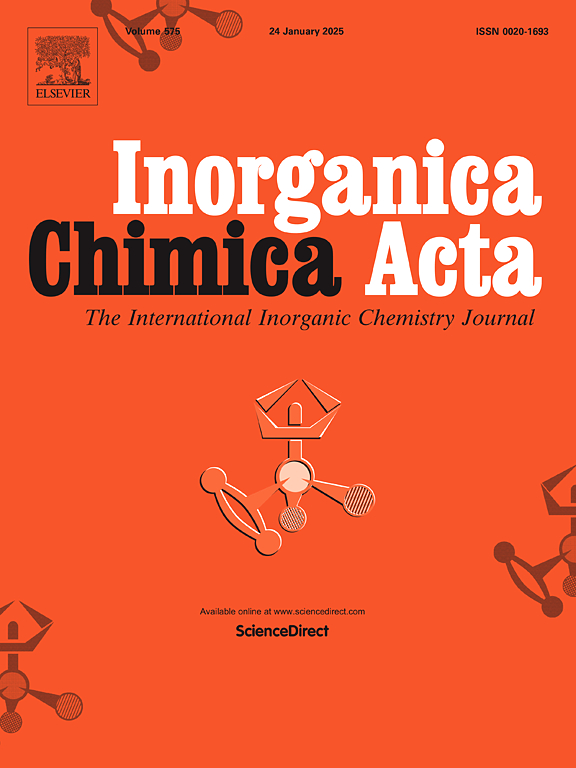吲哚-3-螺(N/N)环三磷腈:合成、光谱、晶体学和热分析
IF 3.2
3区 化学
Q2 CHEMISTRY, INORGANIC & NUCLEAR
引用次数: 0
摘要
本研究合成了四(仲氨基)- n1 -[(1h -吲哚-3-基)甲基]- n2 -甲基螺(N/N)环三磷杂烯,并对其合成、晶体结构、光谱和热性能进行了研究。首先以吲哚-3-甲醛和n -甲基-1,2-二氨基乙烷为原料,以1:1的等摩尔比合成了N1-[(1h -吲哚-3-酰基)甲基]- n2 -甲基-1,2-二氨基乙烷(L1)。六氯环三磷腈(HCCP) N3P3Cl6(1)与等摩尔量的L1反应得到四氯- n1 -[(1h -吲哚-3-基)甲基]- n2 -甲基螺(N/N)环三磷腈(2)。由螺2与过量的吡啶、哌啶、啉和1,4-二恶-8-氮杂螺[4,5]十烷(DASD)缩合反应,分别制备了四(次级氨基)- n1 -[(1H-吲哚-3-酰基)甲基]- n2 -甲基螺(N/N)环三磷杂烯(2a-2d),并通过微量分析、HRMS、FTIR、HSQC、1H、13C和31P等数据证实了新产物L1、2和2a-2d的结构。利用单晶x射线晶体学对2a和2d的分子结构和晶体结构进行了评价。2a和2d的六元N3P3环呈近平面和扁平的船形构象,总褶皱振幅QT分别为0.0419 (14)Å (2a)和0.1192 (23)Å (2d)。此外,用热重分析(TG)和差热分析(DTA)对新合成的磷腈进行了热表征。根据TGA数据测定了化合物的限氧指数(LOI)参数,以确定其抗氧化值。所发现的数值在28.4-31.6之间,表明这些化合物属于自熄材料。本文章由计算机程序翻译,如有差异,请以英文原文为准。

Indolyl-3-spiro(N/N)cyclotriphosphazenes: syntheses, spectral, crystallographic and thermal analyses
In this study, tetrakis(secondaryamino)-N1-[(1H-indol-3-yl)methyl]-N2-methylspiro(N/N)cyclotri-phosphazenes were obtained and their syntheses, crystal structures, spectral and thermal properties were investigated. Primarily, N1-[(1H-indol-3-yl)methyl]-N2-methyl-1,2-diaminoethane (L1) was synthesized from the reaction of indole-3-carboxaldehyde and N-methyl-1,2-diaminoethane in the equimolar ratio 1:1. Reactions of hexachlorocyclotriphosphazene (HCCP), N3P3Cl6 (1), with equimolar amounts of L1 gave tetrachloro-N1-[(1H-indol-3-yl)methyl]-N2-methylspiro(N/N)cyclotriphosphazene (2). Tetrakis(secondaryamino)-N1-[(1H-indol-3-yl)methyl]-N2-methylspiro(N/N)cyclotriphosphazenes (2a-2d) were prepared from the condensation reactions of spiro 2 with an excess of pyrrolidine, piperidine, morpholine and 1,4-dioxa-8-azaspiro[4,5]decane (DASD), respectively, The structures of the new products L1, 2 and 2a–2d were proven by microanalysis, HRMS, FTIR, HSQC, 1H, 13C and 31P data. The molecular and crystal structures of 2a and 2d were evaluated by single crystal X-ray crystallography. The six-membered N3P3 rings of 2a and 2d were in nearly planar and flattened boat conformations with total puckering amplitudes QT of 0.0419 (14) Å (2a) and 0.1192 (23) Å (2d). In addition, the thermal characterizations of the new phosphazenes are evaluated by TG and DTA techniques. The limited oxygen index (LOI) parameters of the compounds were determined from the TGA data to determine their oxidation resistance values. The values found are in the range of 28.4–31.6, indicating that these compounds are in the group of self-extinguishing materials.
求助全文
通过发布文献求助,成功后即可免费获取论文全文。
去求助
来源期刊

Inorganica Chimica Acta
化学-无机化学与核化学
CiteScore
6.00
自引率
3.60%
发文量
440
审稿时长
35 days
期刊介绍:
Inorganica Chimica Acta is an established international forum for all aspects of advanced Inorganic Chemistry. Original papers of high scientific level and interest are published in the form of Articles and Reviews.
Topics covered include:
• chemistry of the main group elements and the d- and f-block metals, including the synthesis, characterization and reactivity of coordination, organometallic, biomimetic, supramolecular coordination compounds, including associated computational studies;
• synthesis, physico-chemical properties, applications of molecule-based nano-scaled clusters and nanomaterials designed using the principles of coordination chemistry, as well as coordination polymers (CPs), metal-organic frameworks (MOFs), metal-organic polyhedra (MPOs);
• reaction mechanisms and physico-chemical investigations computational studies of metalloenzymes and their models;
• applications of inorganic compounds, metallodrugs and molecule-based materials.
Papers composed primarily of structural reports will typically not be considered for publication.
 求助内容:
求助内容: 应助结果提醒方式:
应助结果提醒方式:


